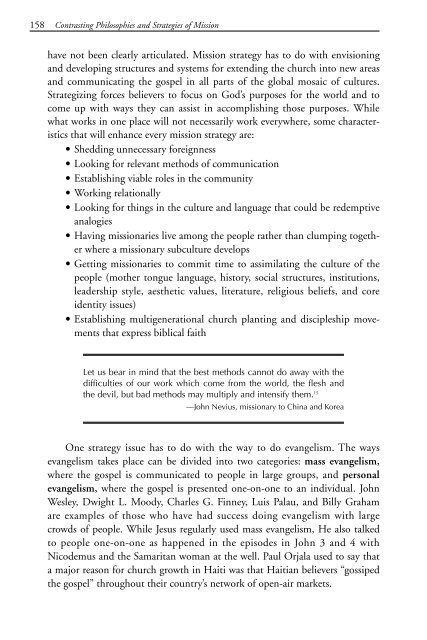discovering missions - Southern Nazarene University
discovering missions - Southern Nazarene University
discovering missions - Southern Nazarene University
You also want an ePaper? Increase the reach of your titles
YUMPU automatically turns print PDFs into web optimized ePapers that Google loves.
245187 Disc Missions ins 9/6/07 1:04 PM Page 158<br />
158 Contrasting Philosophies and Strategies of Mission<br />
have not been clearly articulated. Mission strategy has to do with envisioning<br />
and developing structures and systems for extending the church into new areas<br />
and communicating the gospel in all parts of the global mosaic of cultures.<br />
Strategizing forces believers to focus on God’s purposes for the world and to<br />
come up with ways they can assist in accomplishing those purposes. While<br />
what works in one place will not necessarily work everywhere, some characteristics<br />
that will enhance every mission strategy are:<br />
• Shedding unnecessary foreignness<br />
• Looking for relevant methods of communication<br />
• Establishing viable roles in the community<br />
• Working relationally<br />
• Looking for things in the culture and language that could be redemptive<br />
analogies<br />
• Having missionaries live among the people rather than clumping together<br />
where a missionary subculture develops<br />
• Getting missionaries to commit time to assimilating the culture of the<br />
people (mother tongue language, history, social structures, institutions,<br />
leadership style, aesthetic values, literature, religious beliefs, and core<br />
identity issues)<br />
• Establishing multigenerational church planting and discipleship movements<br />
that express biblical faith<br />
Let us bear in mind that the best methods cannot do away with the<br />
difficulties of our work which come from the world, the flesh and<br />
the devil, but bad methods may multiply and intensify them. 15<br />
—John Nevius, missionary to China and Korea<br />
One strategy issue has to do with the way to do evangelism. The ways<br />
evangelism takes place can be divided into two categories: mass evangelism,<br />
where the gospel is communicated to people in large groups, and personal<br />
evangelism, where the gospel is presented one-on-one to an individual. John<br />
Wesley, Dwight L. Moody, Charles G. Finney, Luis Palau, and Billy Graham<br />
are examples of those who have had success doing evangelism with large<br />
crowds of people. While Jesus regularly used mass evangelism, He also talked<br />
to people one-on-one as happened in the episodes in John 3 and 4 with<br />
Nicodemus and the Samaritan woman at the well. Paul Orjala used to say that<br />
a major reason for church growth in Haiti was that Haitian believers “gossiped<br />
the gospel” throughout their country’s network of open-air markets.

















